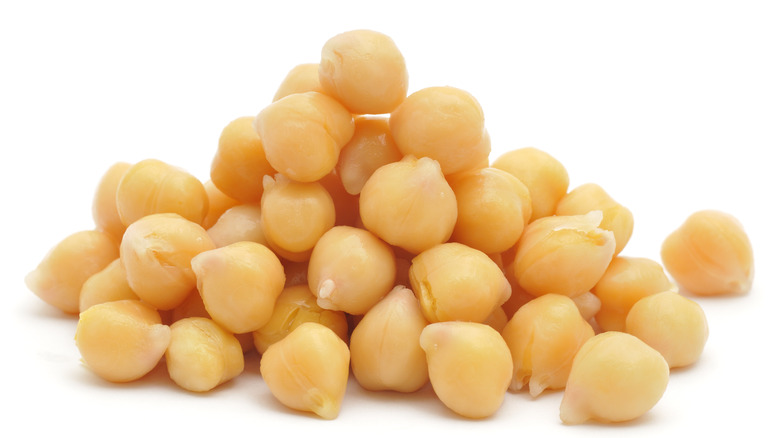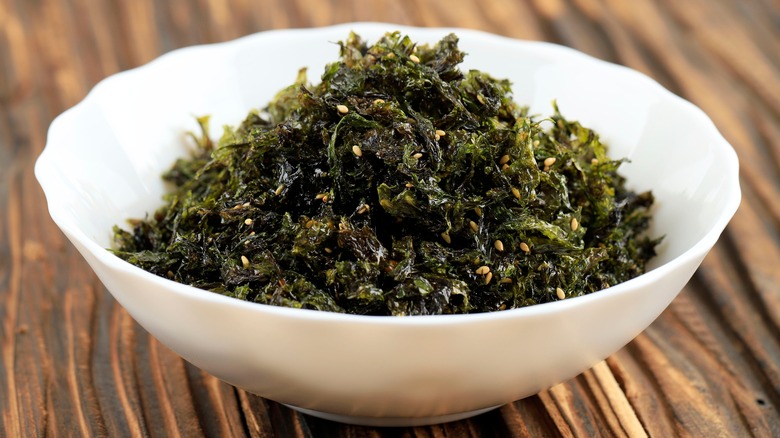The Secret Ingredient José Andrés Tops His Garbanzo Beans With
Spanish chef José Andrés is known for his creative and complex dishes, which often feature "playful theatrics," according to his restaurant chain, The Bazaar's, website. However, at home, the celebrity and humanitarian pursues simpler pleasures.
Andrés enjoys cracking open a can or jar of chickpeas — or, as the Spanish call them, garbanzos — and pouring them into a dish before drenching them in Spanish olive oil and vinegar, and topping them with an ingredient from the other side of the world. He seasons the pantry ingredient with a sprinkle of Japanese furikake with bonito flakes. That's it. He details the snack to "First We Feast" before digging in with a spoon.
The chef's seasoning of choice is a mixture of bright seaweed strips, nutty sesame seeds, salt, and seasonings. Bonito, thin shavings of dried tuna, adds a toasty umami and slight fishiness. The result is a rich, savory, and constantly surprising bite, elevating the humble chickpeas — a nutritious pantry dish — with nuance. "Nothing like chickpeas, my friends," the chef said with a happy chuckle.
How to elevate this simple combination
If the jarred beans that chef José Andrés prefers aren't your style, it's easy to cook up the dried legumes and season the broth with kombu, a type of seaweed often used to make broths and dashi, to complement the briny topping. Though garbanzos are unique in their nutty flavor, we would imagine the pairing works with other creamy white beans. Adding a hit of rich olive oil to the brothy chickpeas, as well as a sliver of citrus zest, will further prime homemade beans for the Andrés-inspired topping.
Furikake seasoning comes in many forms at the store, ranging from wasabi to shiso (made from dried perilla leaves). It's also easy to make at home and customize to your taste. Plus, making your own will allow you to repurpose your kombu strips — and any bonito flakes left over from making dashi — rather than throw them away.
To make the seasoning blend, toast a mixture of sesame seeds, sugar, salt, soy sauce, and sesame oil with your chopped-up ingredients of choice (think seaweed, shiso, or even pickled plum). If you enjoy a deeper fish flavor, add any variety of dried shellfish or fish products, as well as aromatics like herbs and dried citrus peels. To bring out the nuttiness of the chickpeas, consider adding extra white and black sesame seeds or a bit of miso for more umami and salty-sweetness. And, of course, top with plenty of nori when the toasted ingredients cool.
Snacking with Japanese seasonings
Classic uses of furikake seasoning include topping rice, eggs, and vegetables. Though the seaweed mixture shines against blank canvases, like buttery and acidic marinated chickpeas, its sweet and savory profile can hold its own against richer foods. The blend is a sophisticated addition to ramen, but furikake is also a tasty addition to snacks like elote. Some ambitious cooks even give animal crackers and Chex Mix a savory makeover by coating them in the topping.
Furikake isn't the only flavorful topping that can offer flavor and savoriness to mild garbanzos. Enter shichimi togarashi, a spicy, orange-hued Japanese spice blend. The versatile mixture often contains dried red chili, sesame, orange peel, seaweed, and ginger. Though the zesty seasoning will differ from chef José Andrés' fishy favorite topping, the nutty flavor of sesame and nori can still impart familiar notes to a chickpea snack.
The citrus of shichimi togarashi could shine with some of the Andalusian chef's Spanish recipes, like his wife's paprika-heavy chickpea stew or a simple bite of chickpeas and tuna salad. If you're all about the texture, another approach is to season roasted garbanzos with the spicy blend — or fall back on furikake. Both toppings add instant complexity and pair with vegetables, too, making it easy to roast multiple ingredients at once before sprinkling with the stuff.



